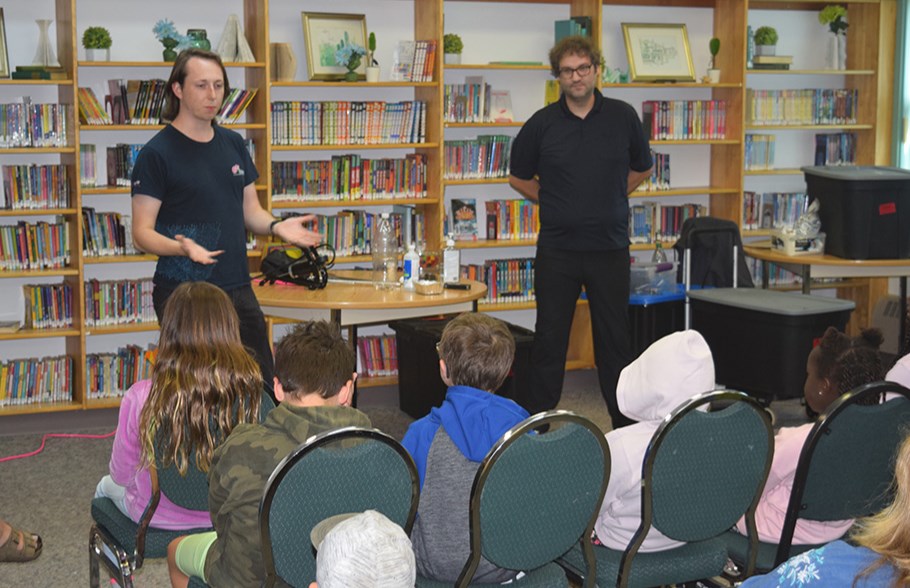CANORA - Evan Tichborne and Jerome Schmeiser of the Saskatchewan Science Centre's Go! Code and GenAction team paid a visit to the Canora Parkland Library on July 18 during Canora in Bloom. Judging from the enthusiasm of the many youngsters in attendance, their message about climate action was well received.
Tichborne told the audience that “The GenAction campaign is to help inform people like yourselves about the earth warming, greenhouse gases, and how we can all help.”
Schmeiser explained that “Water is one of the most common greenhouse gases. In the natural water cycle, water evaporates and forms clouds, which can cool the climate but also trap heat from the sun.”
He asked a volunteer to pump air into a container of isopropyl alcohol to pressurize the liquid, which then turned into a cloud after the bottle, was opened and the pressure quickly dropped. The alcohol was used for the demonstration because it makes the transformation faster than water.
Tichborne mentioned that we often hear in the news about how carbon dioxide is very bad, but that’s not always the case. “It’s not as bad as most people think. We produce CO2 when we breathe, which helps plants to survive and provide food for us to eat.”
The presenters mentioned how the ice age many years ago created a variety of major changes to the planet. Falling meteors caused catastrophic damage, killed plants, and created so much dust that many plants couldn’t survive, which meant animals couldn’t survive.
They went on to add that in recent years, it’s been determined that burning coal and other fossil fuels is one way that human activity is damaging the environment. As a demonstration, Schmeiser roasted a marshmallow and explained that the gases СŔ¶ĘÓƵ released by the burnt marshmallow are similar to harmful greenhouse gases created by burning coal for energy.
“But if we’re going to reduce the burning of coal, we need other ways to create electricity,” said Tichborne. With the aid of two young volunteers, Schmeiser demonstrated using wind for energy to turn a couple of small “turbines,” and added, “Even though we have plenty of wind in Saskatchewan, we can’t rely on it to create energy all the time, so we still need coal.”
Power can also be generated by harvesting energy from the sun, but the sun doesn’t always shine, so again, some coal is still needed.
Since it was a nice day, the group then moved outside to play a greenhouse gas game led by the two presenters. There were two teams: the greenhouse gases and the heat particles. The heat particles entered the earth’s atmosphere from the sun and then tried to escape. The greenhouse gases tried to “tag” the particles to keep them from escaping. If the greenhouse gases won and kept in the heat particles, the planet warmed. If the heat particles won, the earth cooled.
At the end of the presentation, Tichborne asked the youngsters in attendance a number of questions about climate education. Their answers will be presented to climate scientists.
The questions included:
“Can you take shorter and colder showers to save water and heat, which saves power?”
“Instead of buying new toys or electronics, can I fix the ones I have to save resources and save money for my parents?
“Can you convince your parents to cut the grass less often to helps bugs and small insects which are good for the soil?
“Can you talk to friends and family about what you learned today?




